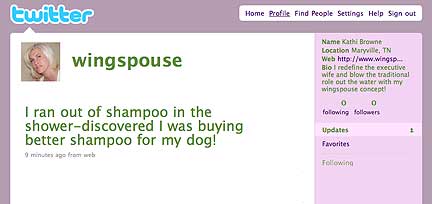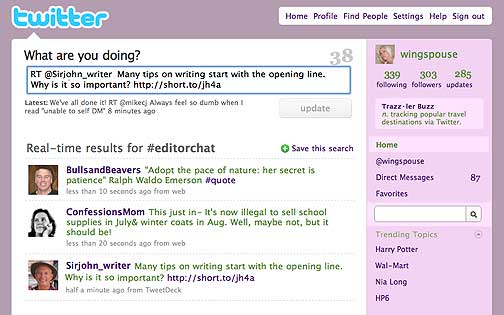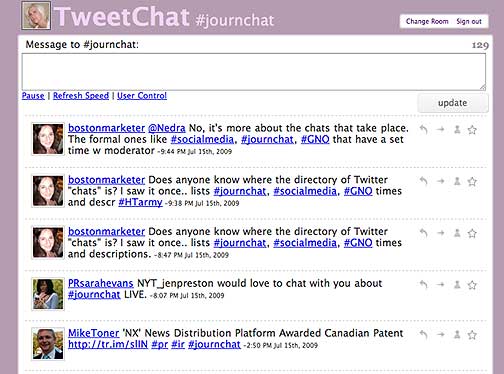this economy, we have to be more than just good writers to be recognized. We need to develop social media savvy. Today’s culture defers to the Internet for instant information, improved purchasing power, and identification of new trends. Until recently, Google was the hottest tool—so much so that google was added to the dictionary as a term used to describe the act of using Google search engine. Now, social media is the latest Internet craze and Twitter is leading the pack.
Twitter enables people from all over the world to communicate rapidly and succinctly in 140-character utterances. That may not sound like an effective way to promote yourself as a writer; but to those who have mastered Twitter, it certainly is! I’ve seen first-hand how one “tweet” can catch the attention of a few “followers.” That same tweet can then be “retweeted” by a follower who has a different set of followers; and in a rapid series of short bursts, my tweet has reappeared over and over, peaking the interest of new fans.
Twitter has spawned a number of related tools used to report the success of this phenomenon. Designed to measure a person’s participation, popularity, and even integrity, successful “tweeters” become known as instant celebrities.
How can Twitter help us? With Twitter, we can create a buzz about our work before it’s released. We can build an image that attracts a larger audience. We can also use Twitter to test-drive ideas and measure how well they are accepted. We can even use Twitter to network with other writers, publishers, and editors and get our name and work out there. I’ve learned so much and made so many new connections on Twitter. Now I’d like to share what I’ve learned with you.

TWEETING 101: Start by building interest in yourself. Twitter is all about peaking people’s interest. Set up a Twitter account using a catchy (and short) username. You want to keep it short, so your name doesn’t use up too many of the 140 characters. Create a bio that mentions your profession and expertise, and share something unusual about yourself. Keep your bio fun and intriguing, rather than dry and professional, and include a webpage if you have one. Add a picture of yourself—one that will surely (and tastefully) catch the attention of others. Once your profile is set up, plan your first tweet. A tweet is a 140-character comment that entertains, informs, motivates, or intrigues others. Since this is your way of creating a first impression, make it good. Here are some examples of some good first tweets:
wingspouse: I ran out of shampoo in the shower—discovered I was buying better shampoo for my dog!
_romance_junkie: just signed contract for a second book and had to share it with someone!
mnsoriano: New to Twitter. It’s like writing Haiku.
With a profile and first tweet in place, you’re ready to enter the virtual cocktail party and attempt to strike up conversations.
TWEETING 201: Attract followers. The upper right corner of your Twitter screen includes a Find People option. Select it and begin searching for others who interest you. You may want to search for the word writer, poet, or publisher. If that seems too boring, try searching for your first name. Pick some of the names that appear and click Follow. It doesn’t matter whom you follow at first. It’s just important that you follow a bunch of people; and if someone new begins following you, follow them back. Reciprocation is the backbone of social media. Private dialog cannot happen unless both parties are following each other.
While you’re building a group of those you are following and those who are following you, continue to tweet daily. Quality is more important than quantity, but quantity is more important at first. Reply to people (by clicking on the curvy arrow to the right of a person’s tweet) once in a while to be more personable. As your following grows, begin to identify the people you enjoy most. Go to their profile, see whom they tweet with, and follow them. You can also select Search from the left sidebar of your screen and look for words that appeared in recent postings. This provides a way to find people who share an interest with you. If your writing appears online somewhere, share it in a tweet by saying something catchy as a lead-in and then providing the URL. This is a great way to direct traffic to your writing.

TWEETING 301: Network with others who can help you. You will begin to identify other people who have wisdom to share. Work on building a relationship with them with periodic tweets. If you’re toying with some new topics, throw out some tweets and see how others react to them. Use Twitter to get a read on your audience and the market in general. Let others see what makes you tick.
When people post something interesting, “RT” (retweet) it and give them credit. This is done by typing “RT @” in front of their username and then repeating what they said:
RT @SirJohn_writer Many tips on writing start with the opening line.
Why is it so important? https://short.to/jh4a
Participate in “Follow Friday” by listing some of your followers for others to follow. Watch how others post on Friday, and you’ll quickly pick up on the proper posting structure. At the right time, send a direct message (it isn’t viewable by the public) to someone you want to network with. Offer your e-mail and an invitation for more personal conversation.
Begin networking inside and outside of the Twitter environment. I’ve found several experienced writers who were happy to give me information I needed. In one case, my name was later forwarded on to a person who was starting a new magazine. Build a relationship where you and your new connection work together by retweeting each other and promoting each other.
I corresponded with a writer who was reluctant to share her editor connections. We built a relationship, and later, she was much more helpful. I thanked her by tweeting a promo of her recently published book. She later sent me information I never thought she would share. You never know who might give you the break you need. When you reach about 300-500 followers, you’ll be ready for graduate level tweeting.
GRADUATE LEVEL TWEETING: It’s time for you to play with the big girls now. Download a personal browser such as TweetDeck or Twhirl or HootSuite. With these tools, you can see your direct messages, mentions (replies directed to you), and general tweets that are taking place—all on one screen. You can also create groups to single out tweeters you want to be sure to see.
Start by creating a group for writers. You may want to include publishers and editors in this group as well. Use the Twitter Search tool on your TweetDeck page (or the Search tool at the bottom of your Twitter page) to look for postings that include #journchat or #editchat. These are hashtags used to identify writer group chats that take place at a scheduled time. As you find people who participate in these chats, follow them and add them to your writers’ group in TweetDeck. Notice what day and time the chat hashtags appear. Begin building relationships with some of the participants.

MASTERING TWITTER: You have mastered twitter when you participate in a group chat. Group chats filter out all the other noise in the Twitterverse and provide for intense brainstorming and relation building. At the appointed chat day and time, go to https://tweetchat.com/ and enter your Twitter username and password. Enter the group hashtag that is taking place (such as #journchat or #editchat) to view live conversations. You can introduce yourself and join in the chat. TweetChat attaches the hashtag for you; but if you choose to participate directly from TweetDeck, don’t forget to include the hashtag after every post you make.
It sounds complicated. But if you just sit back and observe a few times, you’ll catch on quickly. The first time I participated in #journchat, I was reluctant to comment. I didn’t want to remain silent, so I asked a question related to a comment. I was quickly encouraged to participate more. That night, four other writers sent DMs (Direct Messages) to start dialog.
When writers invest time in Twitter, the rewards can be astounding. We can learn about new public interest, upcoming trends, new publications, and even build an audience for future writing projects. We can also meet and build relationships with people who wouldn’t otherwise be available to us. Twitter allows us to do what an agent can’t do unless that agent is ghost tweeting, but that’s another article…
Related Resources for the tweeter:
Twitter Tips:
https://twitpwr.com/4PA/ (great tips for beginners)
https://twittonary.com (explains common Twitter lingo)
https://www.twitip.com/tweet-your-message-to-a-larger-audience-with-hashtags/ (article on hashtags)
Shorten URL Addresses:
https://tiny.cc
https://tinyurl.com
https://is.gd/
https://ow.ly/url/shorten-url
https://bit.ly/
Search Twitter:
https://search.twitter.com/ (official Twitter search)
https://www.twellow.com/ (a “Yellow Pages” directory of Twitter users and businesses)
https://mrtweet.com/ (find Twitter users with similar interests)
Twitter Browsers:
https://tweetdeck.com/
https://old.hootsuite.com/
https://www.twhirl.org/
Hashtags:
https://www.hashtags.org/ (official site that creates, organizes and displays these groups)
https://www.wefollow.com (lists hashtags and who uses them)
https://tweetchat.com/ (facilitates hashtag group chatting)
Photos:
https://twitpic.com (used to post pics on Twitter)
Tools:
https://twitter.grader.com (lists words you tweeted most)
https://www.twitalyzer.com (measures activity/influence)
https://tweetwasters.com/ (calculates how much time you spend on Twitter)
https://www.twitblogs.com/ (allows you to post more than 140 characters, and use photos and video)
***

Kathi K. Browne is a content writer with a creative writing degree and many years of writing experience—both technical and creative. She put her writing career on hold to raise a family and support her husband in his physician executive career. During those years, Kathi discovered how to use her professional skills to compliment her husband’s. In turn, her husband provided the necessary support to launch her next career as a writer and speaker. Now, she inspires other women to embrace a contemporary approach to “having it all.”
She maintains that women can enjoy a powerful role as partners with their husbands to achieve mutual success as a team! Kathi is currently working on a book about her evolution into this non-traditional role she calls a “wingspouse.” She also provides wingspouse tips on her website: https://wingspouse.com/blog.